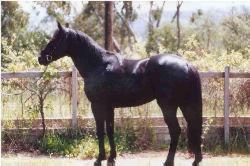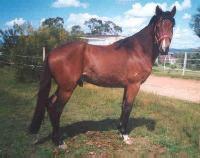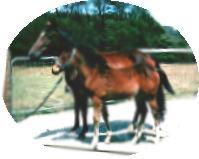| The Waler |  |
Imagine yourself back in history, when ladies rode side-saddle and a man’s worth was often judged by his choice of horseflesh and his horsemanship. In the Waler’s heyday it became the elite mount, the flashy, usually dark coloured equine who would carry you across vast distances to neighbouring properties or into town, where no self-respecting gentleman would be seen on anything but a Waler. During World War 1 they proved themselves to be the superior cavalry mount, the smaller types being champion polo ponies and the larger, unbeatable in the sports of pigsticking and tentpegging. The modern usage of Walers is unlimited, from eventing to endurance, campdrafting or polocrosse, in todays world of specialist horses, it is still the best all-rounder. The Waler type is still the choice of ladies and men alike as a light-weight, active, intelligent, athletic horses has always been No.1 in Australia.
 |
The Waler was a nickname given to horses originally from the colony of New South Wales. (The first Australian Colony, later to become a State.) The Waler was a definite type, but never fixed as a breed. It became famous for its feats of endurance mainly during the Boer War and WW1. |
Early imports of horses to Australia were dominated by Arabian Blood, and the Waler in the 1800's was of obvious Arabian descent. Later more Thoroughbred blood was added and today most people would tell you the Waler was almost without exception sired by Thoroughbred stallions. Arguments still rage today as to which combination produced the best results, but in any case the Arabian/Thoroughbred mixture combined with the climate and excellent breeding ground for horses which Australia could provide, produced a horse of unmatched speed, stamina and agility. Small amounts of other breeds may have been in the horses pedigree as Remount buyers selected by type, and it was the build and conformation of the horse which was important. The Waler was a compact saddlehorse type, average size being 15hh, with clean bone and good hooves. It needed to be a good walker and capable of a charging at the end of a long march. Cross-breeding experiments with heavier types proved largely unsuccessful as the conformation faults took several generations to breed out. Famous poet and war correspondent, Banjo Patterson described the Walers as being light and wiry compared to the English (remount) horses.
 |
The Cavalry horses needed to be able to carry a rider with all his equipment and march at a good pace, where at there destination often had to charge (gallop) over several kilometres into the face of the enemy. The Cavalry fought on horseback, differing to the Mounted Infantry who used their horses for transport, and dismounted to fight on foot. |
The Waler Galloway and Hack Registry Inc, was formed to identify the Waler type and to gather as much historical evidence as possible to ensure the Waler name was properly represented. Later use of the term 'Waler' extended to all Australian horses exported overseas, but the original Waler created the legend. A horse of quality, speed, courage and stamina. The 'WGHR' classifies by type as per the history books, and horses must be either of Thoroughbred, Arabian blood or both with some pony allowable also. Sizes may range from 14 to 16.2hh but the ideal size is 15hh. All colours are allowed. Horses must be quality, compact horses with free movement. Heavy horses were considered detrimental to a good cavalry horse, and are so considered detrimental in today’s Walers.
The Breed StandardDescription
The Waler Horse should have an overall stamp of a Thoroughbred with some, displaying Arabian, Welsh or Timor traits. The horse should be sound of wind and limb, and give an overall impression of good breeding and balance. It should appear capable of long, sustained work under saddle along with weight carrying ability. It should also possess the long lean muscle indictitave of a horse of stamina.
Head
Aristocratic, straight or slightly concave face, proportionate to body and well set on to neck. Flat & broad Forehead, Ears medium and alert. Wide, flexible nostrils. Large, intelligent eye. Jowl deep and wide, throat fine.
Neck
Moderate to long, elegant and reasonably crested.
Shoulder
Ample length and slope.
Body
Deep chest, medium width, well sprung ribs, defined wither, deep girth, short strong back (relative to use) deep through flank, strong loins. Elbows to be free of the body.
Forelegs
Short cannons, long well muscled forearm, elbows clear of body, springy pasterns medium to long, which should slope at the same angle as the shoulder, hooves should be well shaped and preferably dense with concave sole, wide and deep heel. Some fetlock hair allowable but should not show any draught traits.
Hindquarters
Croup flat to sloping, generous hindquarter, long from hip to hock, gaskins long and well muscled, hock strong and flat. Stifles clear of body. Thighs wide and well muscled.
Height
Galloway 14-15hh, Hack over 15-16.2hh.
Colour
All colours, Flecking or spotting may also occur.
Gait
Straight and even in all paces. Free and energetic, showing both speed and agility.
Official Standards of Excellence (c) copyright Waler Galloway & Hack Registry Inc.
| This article and the
accompanying illustrations are kindly provided by the Waler Galloway and Hack
Registry. To learn more about these unique horses please visit their official website - click here |
 |
 |
|